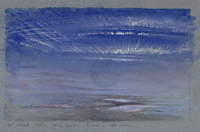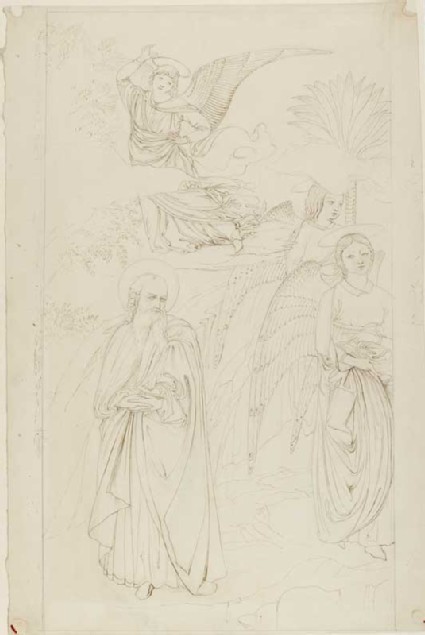Educational, manuscript (1878)
Unpublished manuscript catalogue for proposed re-organisation.

Ruskin's Catalogues: 1 object
Show search help- Reference URL
Actions
Drawing of Abraham parting from the Angels from Benozzo Gozzoli's "Story of Abraham and Hagar" in the Camposanto, Pisa John Ruskin
-
Ruskin text
214.Part of a fresco by Bennozo Gozzo, in the Campo Santo in Pisa : Abraham parting from the three angels , after the talk with them about the Cities of the Plain . Outline made in 1845, my first attempt at study of Italian Art. I wish I could do anything like it now: the head of the principal figure being, as far as I can judge, entirely right in its expression of resignation, and that of the angel above in its sorrow. The original is a very small piece of the great Fresco, and was falling from the wall when I drew it, aA great patch of plaster having come away in the middle of the principal angel's drapery, and under the palm tree. I believe the rest is now destroyed.
-
Details
- Artist/maker
-
John Ruskin (1819 - 1900)after Benozzo Gozzoli (1420 - 1497)
- Object type
- drawing
- Material and technique
- pen and ink over graphite on wove paper
- Dimensions
- 476 x 316 mm
- Inscription
- Recto:
towards bottom, running across the page, in graphite: Abraham & the three Angels | Outline by Ruskin from a fresco by Benozzo Gozzoli in Campo Sant|o
just to the right of the first line of the previous inscription, the Ruskin School's stamp
just below, in ink: M. 30
below the first inscription, right of centre, in graphite: to be Standard 25
bottom, towards right, in graphite: S. 25
- Provenance
-
Presumably presented by John Ruskin to the Ruskin Drawing School (University of Oxford); first recorded in the Ruskin Drawing School in 1878; transferred from the Ruskin Drawing School to the Ashmolean Museum c.1949
- No. of items
- 1
- Accession no.
- WA.RS.STD.025
-
Subject terms allocated by curators:
Subjects
-
References in which this object is cited include:
References
Taylor, Gerald, ‘John Ruskin: A Catalogue of Drawings by John Ruskin in the Ashmolean Museum, Oxford’, 7 fascicles, 1998, Oxford, Ashmolean Museum, no. 022
Ruskin, John, ‘Educational Series 1878’, 1878, Oxford, Oxford University Archives, cat. Educational no. 214
Ruskin, John, ‘The Ruskin Art Collection at Oxford: Catalogues, Notes and Instructions’, Edward T. Cook and Alexander Wedderburn, eds, The Works of John Ruskin: Library Edition, 39 (London: George Allen, 1903-1912), 21, cat. Standard no. 25
Location
-
- Western Art Print Room
Ruskin's Catalogues
-
Educational, manuscript (1878)
214.Part of a fresco by Bennozo Gozzo, in the Campo Santo in Pisa : Abraham parting from the three angels , after the talk with them about the Cities of the Plain . Outline made in 1845, my first attempt at study of Italian Art. I wish I could do anything like it now: the head of the principal figure being, as far as I can judge, entirely right in its expression of resignation, and that of the angel above in its sorrow. The original is a very small piece of the great Fresco, and was falling from the wall when I drew it, aA great patch of plaster having come away in the middle of the principal angel's drapery, and under the palm tree. I believe the rest is now destroyed.





